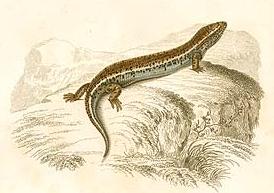
Ablepharus is a genus of skinks that contains the common snake-eyed skinks. Both their scientific and common names refer to the fact that their eyelids have fused to a translucent capsule; as in snakes, they thus are physically incapable of blinking. They are small lizards and prefer to live in the leaf litter of dry fields and hills. Their scales give them a very shiny, bronze appearance with a characteristically dark stripe down the sides of their bodies. They prey on small insects and other small mollusks.

Ophiomorus is a genus of Old World skinks. The limbs are either reduced or absent, depending on the species. They are sometimes known as limbless skinks or snake skinks. Members of the genus live under rocks or in burrows.

Ophisops elegans, commonly known as the snake-eyed lizard, is a species of lizard in the family Lacertidae. The species is endemic to the Mediterranean region and Central Asia. There are nine recognized subspecies.

Eumeces schneiderii, commonly known as Schneider's skink or the Berber skink, is a species of lizard in the family Scincidae. The species is endemic to Central Asia, Western Asia, and North Africa. There are five recognized subspecies.
Ablepharus ladacensis, also known as the Ladak ground skink, is a species of skink found in Tibet (China), North India, western Nepal, and northern Pakistan.

Ablepharus kitaibelii, commonly known as the European copper skink, European snake-eyed skink, juniper skink, or snake-eyed skink, is a species of skink, a lizard in the family Scincidae. The species is endemic to Eastern Europe and Southwestern Asia.
Ablepharus sikimmensis is a species of skink found in Bangladesh (Rangpur), Bhutan, China (Tibet), India and Nepal.

Ablepharus rueppellii, known commonly as Rüppell's snake-eyed skink, is a species of skink found in the Middle East. It was formerly considered a subspecies of Ablepharus kitaibelii, but has since been distinguished. What is currently recognized as this species is possibly two distinct species.

The Greek snake skink is a species of skink, a lizard in the family Scincidae.

Schreiber's fringe-fingered lizard is a species of lizard in the family Lacertidae. The species is endemic to the Middle East.

Chalcides ocellatus, or the ocellated skink is a species of skink found in Greece, southern Italy, Malta, Lebanon, and parts of northern Africa. UAE, Israel, It is also found in Pakistan, India and Sri Lanka.

Chernov's skink is a species of skink, a lizard in the family Scincidae. The species is endemic to northern Eurasia.
Ablepharus lindbergi, Lindberg's snake-eyed skink or Lindberg's twin-striped skink, is a species of lizard in the family Scincidae. It is endemic to Afghanistan.
Panaspis seydeli, also known as the Seydel's snake-eyed skink, is a species of lidless skink, a lizard in the family Scincidae. The species is known from the Democratic Republic of the Congo and Zambia.










